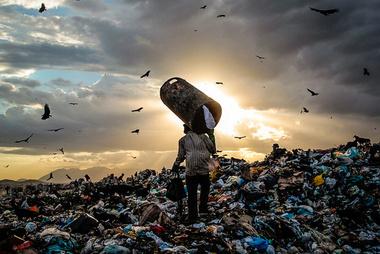
3 minute read
WASTE: IS IT REALLY THAT BAD?
from FAUNA 2023
by ColbyCAH
Sophia Cortese '23
(Reprinted from The Colby Times)
Advertisement
Introduction
Waste. Waste is all the rage. What you do with your waste- how you manage your recycling, compost, and trash are critiqued and heavily discussed Keep a green bin under your sink, unscrew the caps from plastic bottles in the recycling bin, and don't dare put paper towels in the trash Maybe this was just my family, but I think there’s something to be said about a growing trend of greater attention on waste management by way of the products we buy and their path to the afterlife. Food and drink waste, however, are radically different from, say, old clothing and cars. All products are alike, once they’re out of our possession, they seem to just disappear. All in the name of privilege. In the United States, goods aren’t labeled “waste” until we are done with them. As a result, once they seemingly hold no value, they are umbrellaed under a negative connotation that certain societies have built up around discarded items Therefore, to rephrase the earlier statement: I think there’s something to be said about a trend of greater attention on product management while they are still active and valuable to us Although waste earns a negative association in society as discarded value, it brings attention to the global societal inequalities of commodification based upon the created definitions of waste as well as the communities that associate with discarded material.
What is Waste?
First and foremost, waste is, as Professor Britt Halvorson would put it, a cultural categorization of things, places, people, experiences and a dynamic category in time into which things are transformed but do not always assume that role.
By way of shifting a set of practices for remaking and denying value with moral dimensions, waste has always found its way into our favorite unsanitary words, such as “trash talk, junk food and waste of time”. How we view waste entirely depends on how the cultural practices of the communities in which we ascribe to value certain goods and services. When observing the bottled water industry, for example, the plastic from these bottles is seen as one of the leading forms of waste in wealthy countries. Richard Wilk argues that branding has a lot to do with which commodities are seen as beneficial while others are not and even how the same commodity can represent very different ideologies depending on the place: “In poor countries it represents the failure of the government to provide basic public services to citizens, while for the wealthy it has often come to represent waste, environmental destruction, the corruption of children by marketing, and the bankrupt absurdity of mass-consumer society as a whole (see Clarke, 2004).” As a result, in wealthier countries there lies heavy disdain from the use of plastic water bottles and the excess in plastic from bottled water is seen as leading this waste charge. Yet those in poorer countries desire clean, safe drinking water found in the scarcity of plastic bottled water and wouldn’t fall under the same definition of “waste”. While waste is passively defined by communities, waste also actively defines these communities.
The marginalization of migrant workers to the outskirts of Rio de Janeiro structurally created a historically poorer, working based community Uncoincidentally, the regional government created a large dumping ground named Jardim Gramacho for the city's, and its surrounding suburbs, waste in the 1970s which grew to be the largest dump in Latin America (and later in the world). While the dump demonstrated how health and toxicity is linked to the structural inequalities of marginalization, it also created new forms of work like the catadores, or workers who search the dump and collect “recyclable and reusable materials” to be gathered by trucks leaving the dump (Millar 164/5). I believe Millar makes an important statement not to sensationalize or glorify the work of catadores, as she comments they would not glorify their own, but to impress upon the fact that the work of waste and dump is not viewed as trash but of survival and living within social inequality For others, however, scavenging in dumps is not linked to basic survival, and they explore the possibilities that are found within discarded items Joshua Reno cites a worker named Timer who recreated a Chevrolet Malibu from scrap metal found in discarded junk yards. He used the scavenging and building of “waste” to instill lessons onto his sons, find peace in the process alone in his garage, and demonstrate, from the wheel marks and smoke, his skills as a mechanic. For Timer, the process, and not necessarily the final product, is what’s important (Reno 33-35).
“The positive experience of crafting a basket for domestic use out of a rubber tyre may be juxtaposed with the marginalized labour of female, migrant workers in textile reprocessing factories in India such conspicuous consumption may also provide opportunities for other people and places to benefit practically and politically from reuse ” (Reno 2)
Waste isn’t bad. Waste is central to a lot of communities Everyone interacts differently with waste depending on variables, such as geographical region, governmental reforms and economic profitability and most of all structural inequality Waste does not hold a negative connotation for Timer who can use scrap metal for pleasure, as it does not for the catadores who use discarded items for work. Waste does, however, represent larger issues of toxicity, of pollution, of discrimination, of inequality, of injustice, and of capitalism to name of a few.






